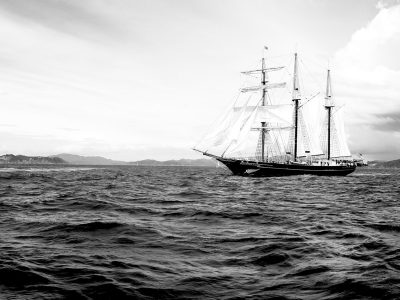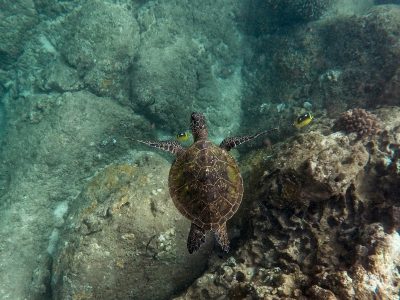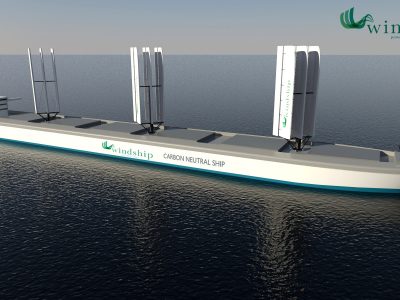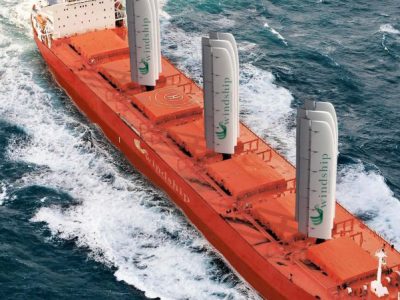The ancient technology getting a second wind – BBC interview
People fixing the world
Our Technical Director, Simon Rogers, was interviewed by Nick Holland on the BBC World Service in May 2020, talking about how the Windship Technology solution can save over 70% fuel and help bulk carriers significantly cut emissions too.
Old ships, powered by the wind, are sailing small amounts of cargo around the world again to help cut pollution. Some of them were built more than 100 years ago.
The shipping industry moves 80% of traded goods around the planet. But the diesel engines that propel modern cargo ships through the oceans burn the dirtiest type of fuel.
Nick Holland speaks to sailors and brokers who, for the sake of the environment, are breathing new life into these vintage vessels.
And he hears how new types of sails could get monster-sized modern cargo ships using the wind as well.
Wind Tunnel Testing
Further Windship Technology testing confirms at least 30% annual fuel and emissions saving for commercial shipping.
Key industry experts, prospective clients in the shipping, commodities and petrochemical sectors together with UK government officials attended the Mitchell – Wolfson Unit Wind Tunnel at the University of Southampton to view the testing of the most recent Windship Technology model in February 2020. The wind tunnel test findings further validated the results of the latest Windship Technology CFD testing. https://www.youtube.com/watch?v=sWH8FrVltAA
The patented UK designed Windship rig system is consistently regarded as the most powerful fuel and emission saving wind system in the market, which will materially help the shipping industry closer towards achieving its 50% reduction in emissions by 2050, as required by the IMO. That organisation has recently acknowledged wind propulsion as one of the solutions for the shipping industry to meet decarbonisation targets, as outlined in the MEPC_C75_Inf26.
The solution, known as the Windship Auxiliary Sail Propulsion System (WASPS), uses fixed wing sail technology, whereby three 35-metre high masts installed on the deck of a vessel will each have three aerodynamic wings fitted (pictured) to exploit the power of the wind. The system allows reductions in engine power to be made in order to achieve the same speed and so maximise fuel-saving and emissions reduction.
Without significant mitigating action it is projected that the global shipping industry could account for almost a fifth of carbon emissions by 2050. Windship’s solution will be able to save a minimum of 30% of the CO2 emissions annually.
The Windship system combined with reduced engine revolutions and other ship optimisation could save up to 80% of fuel and emissions. This aspirational approach will bring closer the possibility of a Carbon Neutral ship well in advance of 2050.
Simon Rogers, Technical Director said, “We are delighted with the results of the wind tunnel testing and they further illustrate how we will help the shipping industry to make a significant reduction in CO2 emissions. We are in discussions with potential development partners to build and install the prototype system.”
Net Zero Emissions Target
As featured in TradeWinds in July 2019, Tanker shipping veteran and long-term proponent of wind propulsion, Lars Carlsson, is proposing a campaign to shift shipowners toward net-zero emission status as the industry begins to get to grips with the IMO target for a 50% cut by 2050.
Carlsson, current director of Windship Technology, a former Managing Director of Concordia Maritime and Chairman of INTERTANKO, wants the industry to set up a World Shipping Board within the IMO to lead a push towards net-zero emissions.
The board, comprising up to 10 people, could "guide us through the coming years' transition, with strong recommendations and executive power, by forcing authorities to legislate for immediate reduction of harmful emissions," he argues in a letter to Trade Winds.
Carlsson, who is now a director at Windship Technology, suggests giving the board 100 votes at the IMO so it can propel legislation through the United Nations organisation for net zero emissions by 2040. Windship is a company developing wind sail rigs for bulkers and tankers aimed at cutting fuel use by 45%.
'Inexcusable delay'
"Kitack Lim, the secretary general of IMO, has a lot of integrity if he could just escape from half of his 200 country delegates' votes in IMO," Carlsson writes.
"Net zero emissions in shipping can be achieved by a determined investment in carbon-neutral vessels. But any target of action as late as 2050 is an inexcusable delay, postponing necessary climate action to the next generation so that we in our generation can enjoy our life and our perks undisturbed by harsh realities," he argues.
Click here to read the full article (subscription required).
Photo credit: Tradewinds
Windship Director races in the Rolex Fastnet Race 2019
Simon Rogers, Technical Director of Windship Technology, and his family participated in the Rolex Fastnet Race 2019. The crew of Assent, a Contessa 32 and the smallest IRC boat in the Race arrived safely in Plymouth at 0430 on 9th August 2019 after an “epic night of lightning, high winds and waves.”
Huge congratulations to the crew (from left): Kit Rogers, Hattie Rogers, Jonah Rogers and Simon Rogers.
Study finds scrubbers will have ‘serious consequences’ on marine life
A new study finds scrubbers will have serious consequences on marine life. Lars Carlsson, from Windship Technology, highlighted the study as he argued for carbon-neutral vessels as emissions regulations get even tighter in the future.
"Let us forbid scrubbers and instead invest in carbon-neutral vessels for net-zero emissions from shipping," he told Tradewinds. "Those who already have rushed to purchase scrubbers in the stampede for cheap fuel, hold your breath for a miracle delay in anti-scrubber legislation."
Read the full article (subscription required).
Wind will play a big part in carbon-neutral shipping
Letter to the Financial Times from Windship Technology Chairman, Robert Elliott, June 2019
Your timely Big Read “Can shipping clean up its act?” (May 31), on the pollution caused by shipping globally, makes key points about the environmental problem caused by the fuel used by the global merchant fleet. The International Maritime Organization has regulated for lower sulphur from 2020 onwards but regulation for carbon emissions has yet to come into force and is some years off. The conservative shipping industry has been slow to adapt and innovate. Scrubbers are not a long-term solution as the pollutants they capture still have to be disposed of safely and not simply discharged into the ocean.
While your analysis touches on wind as a solution, it does not expand on the serious role it has to play and how that might be played, an omission in my view.
The shipping industry has rightly been sceptical about many of the wind power systems proposed in recent years — some of them based on old technology, including simple sails. Progress is being made, however, and powerful new wingfoil designs are being developed, based on America’s Cup technology, which will initially be able to provide auxiliary propulsion with projected annual savings of about 30 per cent in fuel consumption and corresponding reduction in emissions. Naturally, weather routing will play a part in optimising performance and, unsurprisingly, the old trade routes will come into play.
This technology will be capable of being retrofitted on to existing vessels, particularly bulk carriers plying their trade on long voyages, thus retaining value in the current fleet. The “holy grail”, however, will be new-builds with custom-designed hulls, rudders and controlled pitch propellers which, with these propulsion systems and alternative fuels, give a real prospect of developing carbon-neutral ships.
Government Support of Windship Technology
WindShip Technology featured in The Parliamentary Review for Transport 2016/2017.
A consortium set up by five shipping industry leaders to develop a sail power concept, Windship Technology aims to revolutionise the way tomorrow’s large vessels. carry goods across the world’s oceans. But the next critical step, according to its team, is to acquire funding in order to ensure this vision becomes reality.







